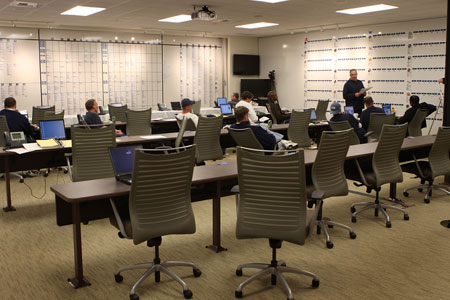The Talent War Room
One of the highlights from Day 1 of The Conference Board's Talent Managment Strategies Conference was a session lead by Ed Colbert, Global Director of Organizational Effectiveness for Dow Corning Corporation.
Ed framed the entire session by sharing a story about how shortly after he was given his role as the Director of Organizational Effectiveness, with responsibility for Talent Acquisition, Learning and Development, Succession Planning, and Workforce Planning, he read an article about how the Director of Player Personnel for a major league baseball team went about his talent management duties.
The Pro Personnel Director's office had one wall covered with pictures of all his team's current starting players, with additional sections describing each players strengths and weaknesses, and some statistics indicating trends in the player's most recent performance. An adjacent area on the wall contained the same information for all the team's substitute players on the current active roster.
The next wall of the office contained pictures and player profiles of the organization's top prospects in the various affiliated minor league teams. These pictures and profiles were organized by role (pitchers, catchers, etc), readiness (players closest to be ready to contribute to the major league club higher on the wall), and color coded by overall 'potential' rating.
Finally the back wall of the office had pictures and profile information of players on other teams (both major league and their affiliated minor league teams) that this Director of Player Personnel was monitoring or tracking for as potential acquisitions for his team in the future. These players represented or had demonstrated both potential targets for filling current needs on his team's active roster, as well as more long-term prospects that seemed to match the team's philosophy or style of play.
As Ed from Corning read the article he came to the conclusion that this Director of Player Personnel had the very same job as he did. The goal of both roles was 'To put the best team on the playing field today, and ensure continued success in the future'.
Assessing the current players was performance management, identifying the strengths and weaknesses of the players was talent profiling and development, examining the capability in the minor league teams was succession planning, and evaluating the external markets for players was talent acquisition and workforce planning.
In fact, Dow Corning has taken the sports metaphor so far as to title the internal communications leader their 'Sports Information Director' and some of their corporate recruiters as 'Talent Scouts'. The Talent Scouts are not just handed open Job Reqs to fill, but rather they are assigned an organization, department, or capability (similar to how the Director of Player Personnel manages the team's talent), and asked to understand the strengths and weaknesses of the current people on their 'team', assess the likely pools of internal successors, and understand and engage the external community of potential talent to further develop Dow Corning's capability to put the best team on the field. It is sort of a 'mini' Player Personnel role, a more active and proactive approach, rather than simply reacting in classic 'search' mode when a position comes open and needs to be filled.
Finally, Ed made the point that while managing the player personnel for a 25-person baseball team is quite a bit more manageable than what most organizations have to grapple with, that the fundamental concepts are really the same. Keeping the process simple, even to the point of using the walls of an office, or even a 'Talent War Room', to keep abreast of the organization's key talent, and most critical roles are keys to a successful talent management strategy and the execution of that strategy.
I knew all that time I spend watching, thinking, and talking about sports would pay off.

 Steve
Steve
Reader Comments (4)
Now you've got your head around KSAOC-centered HRM processes, which are at the core of my domain model. I know nothing about baseball but this same way of thinking is how you win an America's Cup Race in terms of the players, not the technology, or how a good to great practice manager in a professional services organization (which was my last real job) puts together their practice and the project teams within it. I love this story. Thanks for sharing it.
I am not what you'd call a sports fan, but I loved the metaphor here because it was so appropriate! Thanks for sharing it.
Hi Steve - great post and thanks to you and Ed for sharing the example from Dow Corning. Like you I spend a lot of time watching and thinking about sport, and there are some great lessons (and inspiration) for those who manage teams. An interesting book on the subject is 90 Minute Manager - Lessons learned from the sharp end of management. Lots of examples and insight from the UK Premier League (soccer), required reading for fans, team managers and some football managers (you know who I mean!). Andy
If you want to save more time for tasks that matter, implementing automation services like Airslate Notification Automation Bots into your business is a must. An excellent way to determine whether or not you need automation is if you use multiple tools.